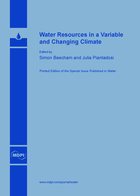Water Resources in a Variable and Changing Climate
A special issue of Water (ISSN 2073-4441). This special issue belongs to the section "Water Resources Management, Policy and Governance".
Deadline for manuscript submissions: closed (13 June 2014) | Viewed by 133310
Special Issue Editors
Interests: water; permeable/pavements; sustainable construction material; eco-efficiency; carbon offset
Special Issues, Collections and Topics in MDPI journals
Interests: stochastic applied optimal control in the area of water management; decision making under uncertainty and environmental applications; climate change impacts on water resources; multi-dimensional copulas of maximum entropy and application to stochastic rainfall models
Special Issue Information
Dear Colleaugues,
Climate change will bring about significant changes to the capacity of, and the demand on, water resources. The resulting changes include increasing climate variability that is expected to affect hydrologic conditions. The effects of climate variability on various meteorological variables have been extensively observed in many regions around the world. Of these, rainfall is one of the most important variables. Understanding the effects of climate variability on spatial and temporal rainfall characteristics is of special interest to water resource policy makers. Investigating rainfall variability at the regional scale is essential for understanding potential impacts on humans and the natural environment. Atmospheric circulation, topography, land use and other regional features modify global changes to produce unique patterns of change at the regional scale. As the future changes to these water resources cannot be measured in the present, hydrological models are critical in the planning required to adapt our water resource management strategies to future climate conditions. Such models include catchment runoff models, reservoir management models, flood prediction models, groundwater recharge and flow models, and crop water balance models. In water-scarce regions such as Australia, urban water systems are particularly vulnerable to rapid population growth and climate change. In the presence of climate change induced uncertainty, urban water systems need to be more resilient and multi-sourced. Decreasing volumetric rainfall trends have an effect on reservoir yield and operation practices. Severe intensity rainfall events can cause failure of drainage system capacity and subsequent urban flood inundation problems. Policy makers, end users and leading researchers need to work together to develop a consistent approach to interpreting the effects of climate variability and change on water resources.
Prof. Dr. Simon Beecham
Dr. Julia Piantadosi
Guest Editors
Manuscript Submission Information
Manuscripts should be submitted online at www.mdpi.com by registering and logging in to this website. Once you are registered, click here to go to the submission form. Manuscripts can be submitted until the deadline. All submissions that pass pre-check are peer-reviewed. Accepted papers will be published continuously in the journal (as soon as accepted) and will be listed together on the special issue website. Research articles, review articles as well as short communications are invited. For planned papers, a title and short abstract (about 100 words) can be sent to the Editorial Office for announcement on this website.
Submitted manuscripts should not have been published previously, nor be under consideration for publication elsewhere (except conference proceedings papers). All manuscripts are thoroughly refereed through a single-blind peer-review process. A guide for authors and other relevant information for submission of manuscripts is available on the Instructions for Authors page. Water is an international peer-reviewed open access semimonthly journal published by MDPI.
Please visit the Instructions for Authors page before submitting a manuscript. The Article Processing Charge (APC) for publication in this open access journal is 2600 CHF (Swiss Francs). Submitted papers should be well formatted and use good English. Authors may use MDPI's English editing service prior to publication or during author revisions.
Keywords
- water resources management
- uncertainty
- meteorological variables
- hydrological models
- climate models







